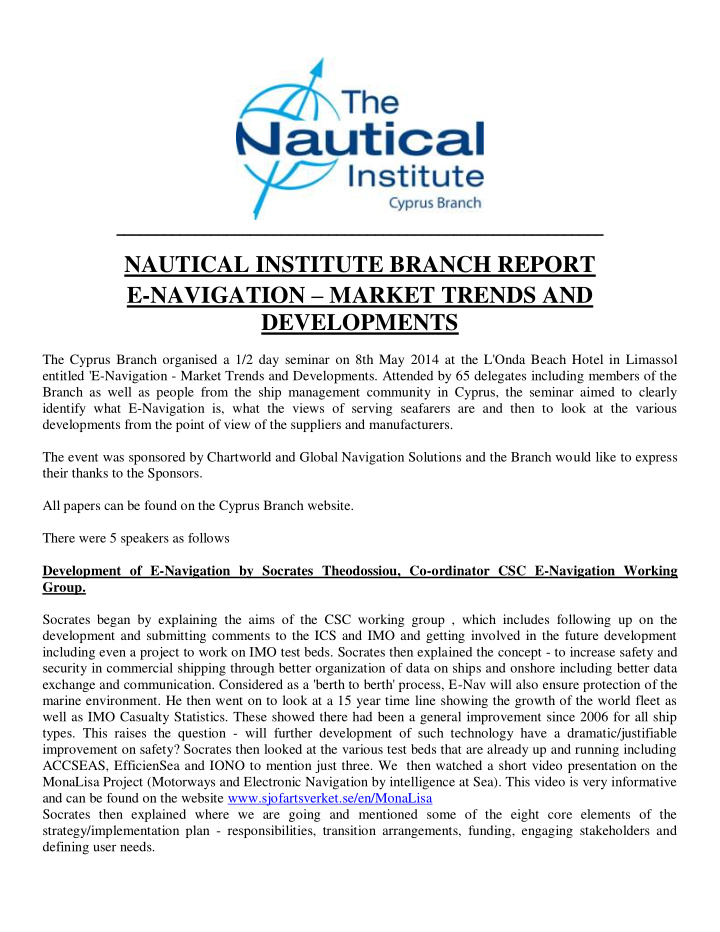



______________________________________________________________ NAUTICAL INSTITUTE BRANCH REPORT E-NAVIGATION – MARKET TRENDS AND DEVELOPMENTS The Cyprus Branch organised a 1/2 day seminar on 8th May 2014 at the L'Onda Beach Hotel in Limassol entitled 'E-Navigation - Market Trends and Developments. Attended by 65 delegates including members of the Branch as well as people from the ship management community in Cyprus, the seminar aimed to clearly identify what E-Navigation is, what the views of serving seafarers are and then to look at the various developments from the point of view of the suppliers and manufacturers. The event was sponsored by Chartworld and Global Navigation Solutions and the Branch would like to express their thanks to the Sponsors. All papers can be found on the Cyprus Branch website. There were 5 speakers as follows Development of E-Navigation by Socrates Theodossiou, Co-ordinator CSC E-Navigation Working Group. Socrates began by explaining the aims of the CSC working group , which includes following up on the development and submitting comments to the ICS and IMO and getting involved in the future development including even a project to work on IMO test beds. Socrates then explained the concept - to increase safety and security in commercial shipping through better organization of data on ships and onshore including better data exchange and communication. Considered as a 'berth to berth' process, E-Nav will also ensure protection of the marine environment. He then went on to look at a 15 year time line showing the growth of the world fleet as well as IMO Casualty Statistics. These showed there had been a general improvement since 2006 for all ship types. This raises the question - will further development of such technology have a dramatic/justifiable improvement on safety? Socrates then looked at the various test beds that are already up and running including ACCSEAS, EfficienSea and IONO to mention just three. We then watched a short video presentation on the MonaLisa Project (Motorways and Electronic Navigation by intelligence at Sea). This video is very informative and can be found on the website www.sjofartsverket.se/en/MonaLisa Socrates then explained where we are going and mentioned some of the eight core elements of the strategy/implementation plan - responsibilities, transition arrangements, funding, engaging stakeholders and defining user needs.
In essence, what this means is that data will be displayed in electronic format, it will minimize navigational errors and therefore accidents, it will raise standards of safety and accuracy to a level commonly found in the air industry and it will use common standards and protocols. Socrates then raised some points for consideration. Some stakeholders and administrations have aspirations for the system to be used for monitoring, controlling and reporting. Is this what E-Navigation is really about? Could it be that electronic equipment is not the cause of accidents but rather that accidents are the result of too much administrative burden and distractions on board. If this is the case - will E-Nav really solve the problem? Did the industry learn anything from the ECDIS lesson? If the problems of ECDIS are repeated then we will not help ships but hinder them. Finally, shall E-Navigation be left to the shipping industry and suppliers to develop or do we need to engage other stakeholders such as Ports and terminals? In concluding, Socrates asked whether maritime security was also to be an issue and pointed to three recent issues which perhaps show that e-technology might not be able to live up to expectations - the failure of the GLONASS system on 4th April 2014, the use of ELORAN GPS and the missing Malaysian Airlines flight MH370. E ‐ NAVIGATION – The Master’s point of View Capt. Valentin Mavrinac is AFNI, QSHE Marine Superintendent at COLUMBIA SHIPMANAGEMENT Limassol, Cyprus His presentation summarized the feedback of 88 management level deck officers, mainly masters. An E-NAV feedback questionnaire has been distributed amongst the officers of several shipping companies serving on board various types of vessels. The questionnaire had a dual purpose – to introduce the E-NAV concept and to challenge critical thinking towards safety of the modern electronic equipment used on board merchant vessels. We expected more an objective opinion than a ‘verdict’ from the seafarers who took part in the research. There was no age group specified, however according to Capt. Mavrinac only 4.5% from all the participants in the research were ‘too old’ to be worried about the E -NAV era and expecting to be fully retired when it hits the world fleet. In general the majority of the officers were positive about the E-NAV regarding: Improvement of safety of navigation Increasing energy efficiency Information availability and data exchange control and tracking of the vessel movement from berth to berth implementation of the traffic corridors and shore based control even for deep sea navigation Major points of concern of the Masters highlighted in the presentation were: - losing the freedom of decision making - when the shore operator will take over data reliability – when the small objects, unexpected obstructions cannot be detected by the radar or satellite used by the shore operator - information overload – when the volume of information to support the decision making cannot be absorbed by the end user - electronic equipment diversity – non standardized equipment, non-user friendly - human error – will E-NAV be able to reduce the consequences of it? Surprisingly the expected increased volume of training for the new electronic equipment was not a matter of concern for the masters. The most preferred methods were CBT and ‘trickle - down’ (on board) training methods according the results of the research.
Recommend
More recommend